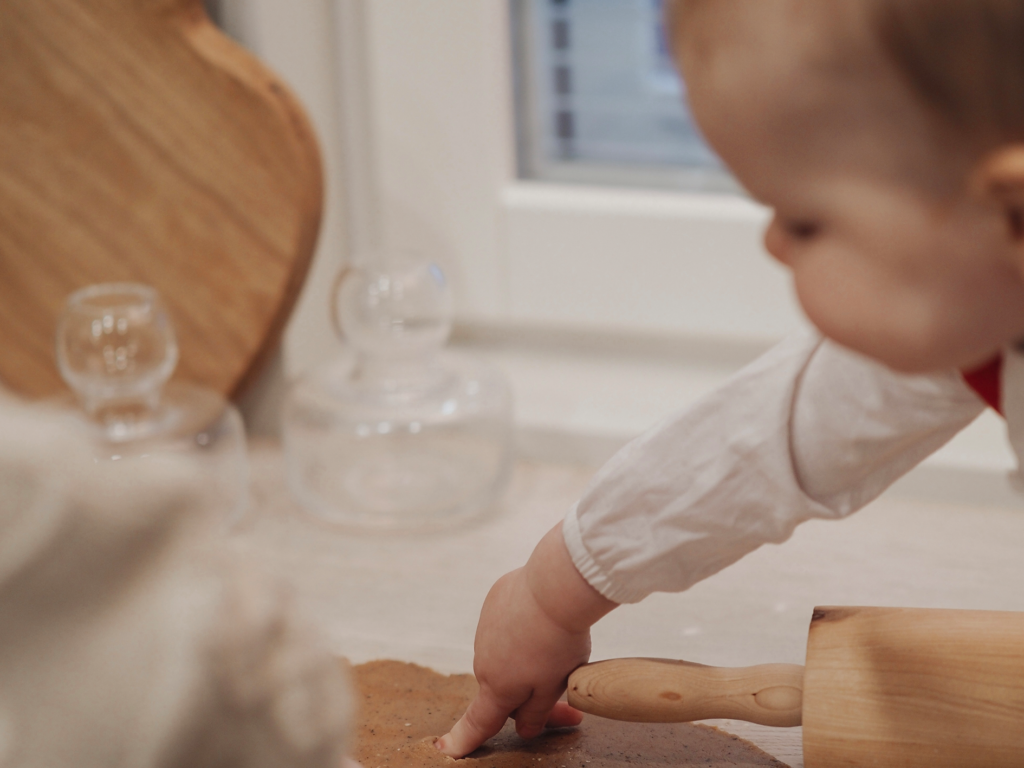Questions about feeding your baby can cause many uncertainties and worries for new parents. In this blog post, we aim to provide a comprehensive guide to baby feeding to help you better understand your baby’s feeding needs and habits. We’ll cover everything from breastfeeding to starting solid foods, and give practical tips for potential challenges.
Baby’s first food experiments: What, when and how often?
A baby’s first feeding experiences are an important stage for both the baby and the parents. This phase usually starts when the baby is around 4-6 months old and ready to try solid foods. It is important to start slowly by offering food in small, easily swallowed portions. At first, you can give your baby single-ingredient chewable foods, such as pureed fruit or vegetables, avoiding added sugar or salt. A new food can be offered to the baby for several days in a row to detect any allergic reactions before trying the next food. The pace of feeding depends on the baby’s interest and hunger, but the starting point could be once or twice a day, for example. It is important to monitor the baby’s cues and willingness to eat, while following the advice of the pediatrician or health professional.
Read tips for expanding your baby’s diet here!
A vegan or vegetarian diet for your baby: What should new parents know?
A vegan or vegetarian diet can be perfectly suitable for babies, but it requires careful planning to ensure that your child gets all the nutrients they need to support their growth and development. It is particularly important to ensure adequate intake of vitamin B12, which is not naturally present in vegetarian foods. Vegan food can provide vitamin B12 if it is enriched or if B12 supplements are used. It is also essential to ensure adequate intakes of iron, protein, calcium, omega-3 fatty acids and vitamin D. Iron can be obtained from whole grains, legumes and dates. Calcium can be found in vegan milk alternatives, tofu and green leafy vegetables. Omega-3 fatty acids are available from sources such as flaxseeds, chia seeds and special supplements from microalgae. Vitamin D intake can be ensured by sunlight and, if necessary, supplements, especially in areas where sunlight is not available. It is advisable to consult a nutritionist when planning a vegan diet for your baby to ensure that your child is getting a balanced and nutritious diet.
Breastfeeding and bottle feeding: Which is the best choice for your baby?
Breastfeeding and bottle-feeding are both acceptable ways to provide nutrition for a baby, and the choice of either approach is a personal decision that can depend on many factors, including the parents’ life situation, health and the baby’s needs. It is generally recommended to breastfeed because breast milk provides complete nutrition for the baby and also provides immunological protection against diseases. The WHO (World Health Organisation) recommends breastfeeding for at least the first six months of a baby’s life, and continuing it alongside suitable solid foods for up to two years or more.
Sometimes breastfeeding is not possible or desirable, in which case bottle feeding can be a good option. It is important to choose a quality infant formula that meets the age-appropriate nutritional needs of your baby. Bottle feeding also offers more flexibility and the possibility for other family members to participate in feeding the baby. Whatever method is chosen, the important thing is that the baby gets the nutrients it needs for healthy growth and development. At the same time, it is important that feeding is a safe and intimate experience for both the parents and the baby.
Small messes inevitably occur at mealtimes.
Baby cutlery: What do you need and how to use them?
When switching from breast milk or formula to solid foods, it is important to choose the right feeding tools for your baby. Baby feeding utensils can be divided into two main categories: firstly, feeding utensils such as small, soft-headed spoons that are safe for the baby’s sensitive mouth, and secondly, feeding surfaces such as high chairs and easy-to-clean bibs. In general, it is advisable to choose BPA-free, non-toxic and dishwasher-safe utensils. Spoons with a soft silicone tip are ideal for first feeding experiences, as they are gentle on baby’s gums and new teeth. For feeding bibs, choose models with a collection tray under the chin for dropped food pieces to reduce mess after feeding. It’s also worth getting bowls of different sizes with tight-fitting lids so you can prepare and store food in advance and transport it easily.
When it comes to the feeding platform, the high chair is a key piece of equipment that should be stable, safe and preferably adjustable as the baby grows. The high chair should be easy to clean, as small messes are inevitable during feeding. Make sure that the safety belts are tight and secure, and that the baby sits correctly and comfortably during feeding. Finally, it is important to remember that when using feeding equipment with a baby, the parent should always supervise the child. Ensure that the utensils used are clean and in good condition. In addition, care must be taken to ensure that the utensils are of the right size and suitable for the baby’s developmental level.
Allergies and baby’s diet: how to recognise and manage allergic reactions?
Allergies and the baby’s diet are important things that parents should consider when starting to give their baby solid foods. The most common foods that cause allergies are milk, eggs, nuts, soy, wheat and shellfish. When starting to introduce new foods, it is advisable to select individual ingredients and introduce them to the baby one at a time, waiting a few days before trying the next one. Experimentation helps to identify possible allergic reactions and ensures that the baby gets used to the new foods safely.
Allergic reactions can take many forms, including rashes, vomiting, diarrhea and, in severe cases, even anaphylaxis. If you notice any signs of an allergic reaction with your baby, it is important to stop giving them this food immediately and contact your doctor. If necessary, your doctor can carry out allergy tests and give you advice on how to proceed. For safety reasons, it is important to be vigilant and react quickly to any allergy symptoms when your baby is eating. Some parents may also decide to follow an approach of exposing the baby to small amounts of potential allergens early on to reduce the risk of allergy in the future, as studies have recommended in some cases. When considering this approach, it is important to talk to a healthcare professional first. In general, safety is always the first priority and when developing your baby’s eating habits you should be vigilant about allergies.

Baby’s mealtime routines: How to create a balanced schedule?
One of the most important steps in introducing healthy eating habits to your baby is to establish regular mealtimes and routines. A sensible schedule will help your child establish regular eating habits and promote better digestion and overall well-being. Set your baby’s own mealtimes that fit naturally into your family’s daily routines and try to keep them the same from day to day if possible.
At first, feeding times should be linked to the baby’s hunger and feeding readiness, but over time the baby will get used to these routines. Create a calm feeding environment and avoid distractions such as TV or other electrical appliances to help your baby concentrate on eating and develop a healthy appetite. Be sensitive to your baby’s signals of hunger and fullness. Do not push to eat if your baby is clearly showing signs of fullness, as it is important for your baby to learn to listen to their own body and regulate their own food intake.
Eating should also be a social event, so whenever possible, eat together as a family. This not only promotes social skills, but also teaches your child good table manners and an appreciation of food from an early age. With positive and consistent eating routines, you can lay the foundation for healthy eating habits that will last a lifetime.
Meal prepping makes daily routines easier, read the tips here!
Creating healthy eating habits for your baby: Tips and advice
Expanding your diet is an important part of your baby’s development and should be done safely and gradually. Introduction to new foods typically starts when your baby shows interest in other foods and is able to eat solids. Introducing new foods to your baby’s diet should be done on a one at a time, preferably every 3-5 days. This allows enough time to monitor any allergic reactions or intolerances. When introducing new foods, keep portions small at first. You can start with a few spoonfuls and observe how your baby reacts. Be patient and wait for your baby to get used to the taste and texture. It is not uncommon for new foods to take several tries to be accepted. Also let your baby play and explore food, as eating is a sensory experience that builds their interest in food and eating.
Make sure that the new foods you introduce are appropriate for your baby’s age and developmental stage. For example, hard and round foods, and other choking hazards, should be chopped into small pieces or pureed until your baby learns to chew and swallow safely. Be sure to provide a varied selection of foods so that your baby gets all the nutrients they need. This includes a variety of fruits, vegetables, whole grains, protein sources and healthy fats. Safety is paramount, and you should approach the introduction of new tastes with a positive attitude. This will allow your baby to enjoy discovering new tastes and develop a taste for a healthy diet.
Expanding your diet: How to introduce new foods to your baby safely?
The most common challenges of feeding a baby can bring worries for new parents. Reluctance to new tastes, difficulty learning to use cutlery and restlessness at mealtimes are examples of these challenges. When your baby doesn’t seem to be getting excited about solid foods, it’s a good idea to use a supportive, low-pressure approach. Offer small tasters and let your child explore new tastes at their own pace. Try to keep mealtimes as stress-free as possible and don’t rush or force your child to eat. If cutlery seems awkward or intimidating, try a variety of designed feeding products that are age-appropriate for your child. Feeding utensils that are often easy to handle, fit into a small handhold and allow the baby to eat independently can be helpful.
Restlessness at the dinner table can be alleviated by short, quiet mealtimes. Ensure that the environment is calm and low disturbance. Every baby is individual, so a parent’s own intuition and understanding of the child is also important in overcoming challenges. When facing difficulties, remain calm and remember that feeding skills develop as the baby grows. If necessary, do not hesitate to seek support and guidance from a health professional.
Eating skills develop as the baby grows.
Baby’s diet impacts on sleep: How can food affect your baby’s sleep patterns?
The relationship between your baby’s diet and sleep patterns is part of the great mysteries of parenting. It is generally accepted that a well-fed baby sleeps better, but the link between food and sleep is not unequivocal. A fully nourished baby’s stomach can promote longer, uninterrupted sleep, especially at night when blood sugar levels remain more stable. On the other hand, overeating or poorly digested foods can disturb a baby’s sleep by causing stomach aches or heartburn. When a baby is introduced to solid foods, many parents may notice changes in their baby’s sleep patterns. Some babies may start sleeping better, while others may become restless as they experience new tastes and digestive experiences. It is important to understand that each baby is an individual and will react differently to changes in diet.
It is recommended that you avoid heavy or large meals just before bedtime and focus on lighter meals that allow enough time for digestion before bedtime. Calm, night-calming routines, such as a warm bath and a quiet mealtime, can also help you to get a good night’s rest. When faced with sleep disorders, patience is key and parents should adjust their diet and circadian rhythms to meet their child’s individual needs.
Common challenges in feeding your baby and how to overcome them
Common feeding challenges for babies can include trying new foods, establishing eating habits and following special diets. Many babies may initially reject solid foods or show aversion to certain tastes and textures. Continuous tasting and providing a positive eating experience are important steps towards acceptance of new foods. Remember that it may take several tries before your baby gets used to the new taste. Establishing eating routines can also present challenges, as babies need time to get used to new schedules. Be patient and determined, but flexible, as babies’ hunger and tiredness can vary from day to day. Routines at mealtimes will help your baby to feel safe and calm at mealtimes, which will encourage better eating behaviour.
On the other hand, providing a special diet for your baby, such as a vegan or allergy-restricted diet, requires careful planning and possibly expert advice to ensure that your baby gets all the nutrients they need. Overall, the challenges associated with feeding your baby are usually temporary when parents provide consistency, support and encouragement. If you do encounter barriers, remember that you can always turn to professionals such as a pediatrician or a nutritionist for advice and support.










